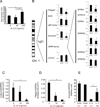Coordinate interaction between IL-13 and epithelial differentiation cluster genes in eosinophilic esophagitis
- PMID: 20208004
- PMCID: PMC3807813
- DOI: 10.4049/jimmunol.0903069
Coordinate interaction between IL-13 and epithelial differentiation cluster genes in eosinophilic esophagitis
Abstract
We have previously proposed that the pathogenesis of eosinophilic esophagitis (EE) is mediated by an IL-13-driven epithelial cell response associated with marked gene dysregulation including eotaxin-3 overproduction. In this study, we compared epithelial responses between healthy patients and those with EE, aiming to uncover molecular explanations for EE pathogenesis. Esophageal epithelial cells could be maintained for up to five passages, with 67% and 62% of cell lines reaching confluence in healthy controls and EE cases, respectively. Both sets of epithelial cells avidly responded to IL-13 at similar levels as assessed by eotaxin-3 production. Acidic pH increased cellular release of eotaxin-3 (4.6 +/- 1.98 ng/ml versus 12.46 +/- 2.90 ng/ml at pH 7.4 and 4, respectively; p < 0.05). Numerous epidermal differentiation complex (EDC) genes, such as filaggrin and SPRR3, were downregulated both in IL-13-stimulated esophageal epithelial cells and in EE biopsies specimens compared with healthy controls. Whereas the filaggrin loss of function mutation 2282del4 was overrepresented in EE compared with control individuals (6.1% versus 1.3% respectively; p = 0.0172), the decreased filaggrin expression was uniformly seen in all EE cases in vivo. Indeed, expression of the EDC genes filaggrin and involucrin was strongly decreased directly by IL-13. These results establish that the epithelial response in EE involves a cooperative interaction between IL-13 and expression of EDC genes.
Figures





References
-
- Furuta GT, Liacouras CA, Collins MH, Gupta SK, Justinich C, Putnam PE, Bonis P, Hassall E, Straumann A, Rothenberg ME. Eosinophilic esophagitis in children and adults: a systematic review and consensus recommendations for diagnosis and treatment. Gastroenterology. 2007;133:1342–1363. - PubMed
-
- Lierse W. The physiology and pathology of the esophagus. Eur J Pediatr Surg. 1992;2:323–326. - PubMed
-
- De Benedetto A, Qualia CM, Baroody FM, Beck LA. Filaggrin expression in oral, nasal, and esophageal mucosa. J Invest Dermatol. 2008;128:1594–1597. - PubMed
-
- Crish JF, Bone F, Banks EB, Eckert RL. The human involucrin gene contains spatially distinct regulatory elements that regulate expression during early versus late epidermal differentiation. Oncogene. 2002;21:738–747. - PubMed
Publication types
MeSH terms
Substances
Grants and funding
- DK076893/DK/NIDDK NIH HHS/United States
- AI070235/AI/NIAID NIH HHS/United States
- R37 AI045898/AI/NIAID NIH HHS/United States
- R01 AI083450/AI/NIAID NIH HHS/United States
- AI45898/AI/NIAID NIH HHS/United States
- P30 DK0789392/DK/NIDDK NIH HHS/United States
- Z01 NR000014/ImNIH/Intramural NIH HHS/United States
- R01 AI045898/AI/NIAID NIH HHS/United States
- U19 AI070235/AI/NIAID NIH HHS/United States
- R01 DK076893/DK/NIDDK NIH HHS/United States
- AI079874-01/AI/NIAID NIH HHS/United States
- R21 AI079874/AI/NIAID NIH HHS/United States
LinkOut - more resources
Full Text Sources
Other Literature Sources
Medical
Molecular Biology Databases

